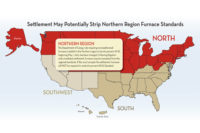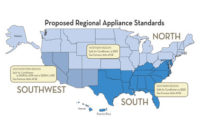
On Feb. 17, Sen. Jeff Bingaman, D-N.M., introduced a bill in the Senate to update the efficiency standards for a host of appliances and building systems, including furnaces, heat pumps, and central air conditioners. Titled the “Implementation of National Consensus Appliance Agreements Act of 2011,” or INCAAA, the bill (S. 398) divides the nation into three regions with different efficiency standards for each. It also recommends more stringent building codes for new construction.
INCAAA is cosponsored by Sen. Lisa Murkowski, R-Alaska. Bingaman is the chairman and Murkowski is the ranking member of the Senate’s Energy & Natural Resources Committee, which the bill was referred to after its introduction.
The INCAAA bill is based on the consensus standards agreement signed in October 2009 by major industry associations, including the Air-Conditioning, Heating, and Refrigeration Institute (AHRI) and more than a dozen individual furnace and air conditioner manufacturers. According to David Calabrese, senior vice president of policy at AHRI, the consensus standards were developed in response to the Obama administration’s push for higher standards. “When the Obama administration came in, they made it very clear that they intended to increase the standards,” he said. As a result, AHRI chose to engage with leading environmental groups to craft the new standards. “We decided that it was important to work cooperatively with environmental groups and to fashion them,” Calabrese explained.
PROPOSED REGIONAL STANDARDS
According to Calabrese, “The bill includes new standards for central air conditioners, heat pumps, and furnaces in three regions of the country; essentially, there are different standards for each region, taking into account the climatic conditions in each.”The INCAAA bill divides the United States into three regions: North, South, and Southwest. Specifically, the North region comprises states with population-weighted heating degree days (HDD) equal to or greater than 5,000; the South comprises states with population-weighted HDD less than 5,000; and the Southwest comprises Arizona, California, Nevada, and New Mexico.
According to an AHRI fact sheet, in the North region, most furnaces will be required to have an AFUE of 90 percent or more, an increase from the current national standard of 78 percent. In the South, central air conditioners will be required to have a SEER of 14, up from the present national requirement of 13 SEER. Heat pump and oil furnace standards will rise on a nationwide basis.
AHRI also noted that the standards apply to residential single-phase air conditioners and heat pumps less than 65,000 Btuh of cooling capacity (except through-the-wall and small duct, high velocity products), and single-phase weatherized and non-weatherized forced-air furnaces (including mobile home furnaces) below 225,000 Btuh heat input.
For split air conditioners, minimum EER values are specified for the Southwest region.
If the bill is passed, the new standards for nonweatherized furnaces would become effective in 2013, with the new standards for air conditioners, heat pumps, and weatherized furnaces following suit in 2015.

Table 1. Minimum Federal Standards (Retrofits)
BUILDING CODE REVISIONS
Not only does the INCAAA bill provide new standards for appliances, it also gives the Department of Energy (DOE) the ability to authorize new building codes at the state level. According to Calabrese, “It provides DOE the authority to establish levels that states could adopt in their building codes. Right now [the states are] prohibited from establishing anything in their codes that would be different from the federal minimum standards. This would allow them to go beyond the federal minimum standards to levels that are identified in the legislation.”These levels would be applicable for new construction and major renovations in each of the three regions. Calabrese added that this is a unique provision in the bill, since DOE currently does not have this authority.

Table 2. Energy Efficiency Standards for Performance-Based Building Codes (for new construction and significant-upsizing only)
WILL THE BILL PASS?
According to AHRI, the last version of this bill “nearly passed under unanimous consent during the December 2010 ‘lame duck’ session.” Now, passing the bill is one of the association’s top priorities in 2011.“Now we’re looking at what can happen in the Senate, and how do we move it in the House,” Calabrese said. The critical aspect to passing the bill in the Senate, he explained, is finding the right legislative vehicle for it. If INCAAA were to be considered as a standalone bill, Calabrese said it would have a high likelihood of passing. However, he added, “Standalone bills are very rare.” Because of the press of legislative activity, senators generally pair bills into larger pieces of legislation. “My concern is that if the vehicle is a larger energy bill that has opposition or concern from others, then it could get tied up in that,” Calabrese said.
While the Senate is generally perceived as being favorable toward the bill, it is harder to predict how the House would receive the bill. “It’s hard to say with the new leadership there,” Calabrese said. He did point out, however, that the bill has the support of many industry groups and environmental groups, as well as the support of the Obama administration.
Publication date:04/04/2011






